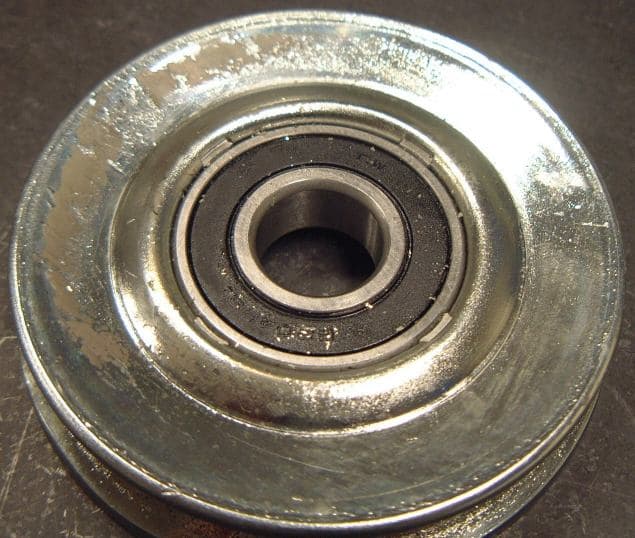
-----
Zinc plating is peeling off during transit
Q. We are doing zinc plating with blue passivation (trivalent) with lacquer coating for spun pulleys. we observed flaking/peel off of chromate layer with base zinc plating intact. This occurs when parts are shipped through sea from India to Europe. Adequate consideration has already taken for packaging & we feel, it is a plating process problem.
Please suggest any process improvement and possible causes of occurrence for this defect.
auto component supply to Global Tier 1 & OEM's - Pune, Maharashtra, India
2005
First of three simultaneous responses -- 2005
A. Dear sir,
Please check whether your plating process is acid or alkali. In both cases proper washing is required, followed by 5% nitric acid bright dip. This will improve your passivation adhesion.

P. Gurumoorthi
electroplating process chemicals - Chennai, Tamilnadu, India
Second of three simultaneous responses --
A. Happy Holidays!
Before I can give you an educated answer, I would need to know your steps after Zn plating. Process steps, times and temps, type of drying technique, etc. Thanks!
process engineer - Malone, New York
2005
Third of three simultaneous responses --
A. Hi,
Please let us know the kind of plating (acid or cyanide or alkaline) and the type of passivation: yellow or blue, trivalent or hexavalent, and the process sequence.
I think with this information many can assist you

Praveen Kumar
plating process supplier
Mumbai, India
2005

(photo of failed pulley)
A. Sunil.
From the picture I can see, it looks like your zinc plating also peels off.
Your problem is the pretreatments steps before zinc, not the chromate.

Anders Sundman
4th Generation Surface Engineering
Consultant - Arvika,
Sweden
2005
2006
A. Sunil,
look at the component keep proper temp., introduce soak and electro cleaning. Change acid in pickling stage. Your problem will be solved.
But it's not at all a passivation problem.
Regards

T.K. Mohan
plating process supplier - Mumbai, India
2006
Q. I am Sunil's colleague and would like to answer some of the queries about the process followed. We thank everyone for giving their valuable inputs.
A. Pre Treatment
1) Hot soaking in alkaline solution concentration of 100 gm/lit at 80 - 90° C. Duration:3 - 5 min
2) Water Rinse twice
3) Pickling in 50% V/V HCl with 20 - 30% concentration to remove rest / scale
4) Water Rinse thrice (2 times in fresh water and then in water containing drag out cyanide bath to give a ready to absorb surface for plating)
B. Plating in High Cyanide Zinc plating Electrolyte under 5 Volts. Duration: 10 to 15 min for average coating thickness of 12 to 17 microns
C. Post Treatments
1) Remove drag out solution by water rinsing (twice)
2) Bright Dip in 1% HNO3
3) Water Rinse
4) Blue Passivation - Trivalent
5) Water rinse 2 to 4 times
6) Clear Lacquer - Single dip
7) Air drying at room temp
8) Normalizing time (48 hrs post plating)
We would like to know the significance of "Normalizing time" since this is suggested by our plating chemical supplier.
- Pune, Maharashtra, India
First of two simultaneous responses -- 2006
A. Sunil/Hattangadi
Try to introduce electrocleaner immediately after soak clean. You may straightaway go to electroclean with or without water swill in between.
Normalising time is Curing time. Passivations especially trivalent passivations are fragile immediately after plating and it is better not to handle it immediately after plating. Minimum 24 hours curing is recommended for better salt spray life and in turn better corrosion resistance.
Regards

T.K. Mohan
plating process supplier - Mumbai, India
Second of two simultaneous responses --
A. You have no electrocleaner in your line!
That is the problem.
You can try to improve the situation by double zinc plating. After you plate the zinc (2-4 microns are enough), strip it in acid and replate. The first plating can act as an electrocleaner. (but a real electrocleaner is preferred).

Sara Michaeli
Tel-Aviv-Yafo, Israel
2006
A. From your picture its one of probably two causes:
1) In your spinning process, you are probably using organic compounds which leave invisible traces of some substances leading to peel off. In this case stripping and replating is a good idea.
2) Your cyanide zinc bath has an overdose of crappy zinc brightener, sack the plater and his additive supplier!

Khozem Vahaanwala
Saify Ind
Bengaluru, Karnataka, India

2006
Q. Hi I just bought a small plating company, I really don't know much about the process but I am learning.
I have some parts that I am trying to zinc plate but the zinc keeps on cracking. Can someone help? I sent the acid for analysis but it came back fine; any suggestions?
Plating Shop - Monterrey, Nuevo Leon Mexico
June 19, 2012
A. Hi Omar.
We appended your inquiry to one of many threads about zinc plating peeling. You can use the Google custom search engine near the top of this page to find the additional threads on the subject.
My first suggestion is to try to get the supplier of your zinc plating process involved. Usually they can not only analyze your solutions, but offer hands-on help, and run sample parts.
Regards,

Ted Mooney, P.E.
Striving to live Aloha
finishing.com - Pine Beach, New Jersey
Ted is available for instant help
or longer-term assistance.
A. There may be the chance of not monitoring plating bath concentration up to optimum range.
Else there may be a gap in the pickling process.
For effective plating, material should be cleaned properly.
- Mumbai, Maharastra, India
August 17, 2012
Q. Do zinc plated parts from trivalent blue passivation + lacquer + baking in oven at 80 °C require curing for 24 hours ?
S.W DESHPANDE- India
October 2, 2012
Q, A, or Comment on THIS thread -or- Start a NEW Thread